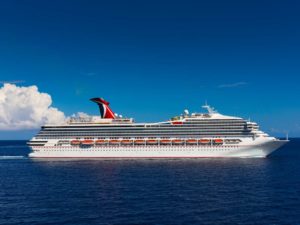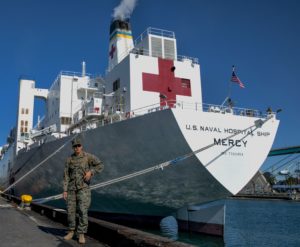 The Carnival Surprise Could Be Deployed As A Floating Hospital (Photo: Carnival Corporation)
The Carnival Surprise Could Be Deployed As A Floating Hospital (Photo: Carnival Corporation)
By Stas Margaronis
Carnival Cruise Line, Holland America Line, Princess Cruises and P&O Cruises Australia are offering to convert some cruise ships into temporary hospitals for non-COVID-19 patients. Carnival Corporation says it will offer up to 15 cruise ships for use as floating hospitals that could be deployed at U.S. ports.
Each Carnival cruise ship that is being offered has a 1,000-person single occupancy capability.[1]
A cross-section of the deck plan to the Carnival Sunshine gives an indication as to how patients can be housed on a cruise ship:[2]
Currently, the USNS Mercy, is deployed at the Port of Los Angeles and contains 1,000 hospital beds. It is being deployed to provide care for non-Covid-19 patients.
The decision to deploy the USNS Mercy came from Governor Gavin Newsom. A spokesman for the Port of Los Angeles described the sequence of events that brought the Mercy to Los Angeles: “The short answer is Newsom requested it, County requested it, LA mayor and Council wanted it. We moved quickly to work with Navy to make it happen… And, of course, it didn’t come until the Federal government ordered it. Cal Office of Emergency Services also involved.”
On March 30th, Port of Long Beach Executive Director Mario Cordero revealed that the City of Long Beach and Carnival are in discussions about locating a cruise ship at the Port as a floating hospital ship: “Carnival Cruises has been in discussion with the City of Long Beach about the possible deployment of one or more cruise ships as floating hospitals for non-COVID-19 patients. The Port of Long Beach has been involved with these discussions. The Port has proposed several sites at the Port complex. One issue that is still not resolved is which patients might be relocated onto the cruise ships. As you know the USNS Mercy is already providing a floating hospital function for non-COVID-19 patients at the Port of Los Angeles. A decision about Carnival’s offer has yet to be made by the City.”
On Thursday March 26th, Carnival Corporation issued a statement stating cruise ships are available from Carnival Cruise Line, Holland America Line, Princess Cruises and P&O Cruises Australia and that they could be converted into temporary hospitals for non-COVID-19 patients. The ships could be used to relieve pressure on land-based hospitals and free up capacity, i.e. provide extra beds, to care for non- COVID-19 patients. On board medical clinics can provide up to seven intensive care units, according to Carnival. The statement went on to say: “If needed, cruise ships are capable of being quickly provisioned to serve as hospitals with up to 1,000 hospital rooms that can treat patients suffering from less critical, non-COVID-19 conditions…These temporary cruise ship hospital rooms can be quickly converted to install and connect remote patient monitoring devices over the ship’s high-speed network – providing cardiac, respiratory, oxygen saturation and video monitoring capabilities. The rooms also have bathroom facilities, private balconies with access to sun and fresh air, as well as isolation capabilities, as needed.”
As part of the offer, Carnival said interested parties will be asked to cover only the essential costs of the ship’s operations while in port.[3]
On Friday March 27th, a Carnival spokesperson provided additional details specific to the Carnival offer:
* “Cruise ships could be immediately deployed to U.S. ports at Los Angeles and Long Beach, New Orleans, Boston, New York,” and Northern California and Florida ports.
However, a March 26th Centers for Disease Control (CDC) report, “Public Health Responses to COVID-19 Outbreaks on Cruise Ships — Worldwide, February–March 2020” warned about vulnerability of cruise ships to the COVID-19 threat stating: “Cruise ships are often settings for outbreaks of infectious diseases because of their closed environment and contact between travelers from many countries.”
* In response, Carnival says it is addressing these concerns and is working with CDC officials and “will be able to meet all CDC decontamination requirements for the vessels.”
* One concern is that cruise ships use shared ventilation systems that, under current conditions, might pose a virus contamination threat to patients on the vessel. Carnival responded: “We are aware of concerns about shared air ventilation systems on our vessels and we are able to make adjustments to fresh air ventilation so as to eliminate any concerns… We are prepared to make these adjustments that are needed to accommodate hospital patients who are non-COVID-19 exposed and we believe we can make these adjustments fairly quickly.”
* Each Carnival cruise ship has a small hospital facility that can accommodate up to 25 patients.
* Carnival has been using a CDC recognized decontamination agent to clean its vessels and make them free of contamination.[4]
A U.S. Naval Institute report posted on March 29th describes the USNS Mercy’s deployment at the Port of Los Angeles. It is based on an interview with Captain John Rotruck, commander of USNS Mercy’s Medical Treatment Facility (MTF). The interview gives some guidance of how cruise ship hospitals might operate:
“It’s unclear how long Mercy will remain in Los Angeles and whether it would be diverted to another port. ‘We are here… basically as long as FEMA and the state of California deem that it’s a value-added proposition for them… We are here to serve and happy to be here. When they tell us, they don’t need us anymore, we will set sail.”
Also unclear is how long patients would remain aboard the ship. There’s “no specific limitation. As long as we’re here, they can be here,” Rotruck said. “We’re going to get some assistance from the local hospitals and the county to help with discharge planning, because that’s not a function that we typically do. Here, we are talking about discharging people home with the potential of home health services and durable medical equipment. That’s not a skill set that we generally have residing in uniform.”
Patients brought to Mercy will face the same visitation restrictions enacted at many medical treatment facilities across the country grappling with the COVID-19 outbreak.
 Pfc. Arnoldo Romero Velazco, with 1st Battalion, 4th Marine Regiment, 1st Marine Division, post security to secure the Military Sealift Command hospital ship USNS Mercy (T-AH-19) in Los Angeles, Calif., on March 27, 2020. (US Navy Photo)
Pfc. Arnoldo Romero Velazco, with 1st Battalion, 4th Marine Regiment, 1st Marine Division, post security to secure the Military Sealift Command hospital ship USNS Mercy (T-AH-19) in Los Angeles, Calif., on March 27, 2020. (US Navy Photo)
“We have a strict no-visitor policy for the ship,” Rotruck said, but “we certainly want to make sure people get to stay in touch with their families.” Phones and internet access will be available for patients, he said, so they can call or text family members.
Restrictions also are in place for the 800-plus crew of enlisted sailors and officers and a handful of contractors, making Mercy their pier-side home for the foreseeable future. Also aboard are 76 civilian mariners, twice the ship’s typical crew when at home port. The crew is housed aboard in berthing spaces for enlisted sailors and staterooms for officers, as well as the crew of civilian mariners.
“Nobody is leaving the ship, and that’s a force health protection measure to make sure that we don’t inadvertently expose our crew to increased risk of COVID,” Rotruck said. “We’re going to do our very best to not introduce additional risk by bringing COVID onto the ship.”
Rotruck said his message to the MTF crew, many who came from shore-based hospitals and clinics was to maintain the same standards for patient safety and high-quality care as if they were at their shore-based medical treatment facilities. “For all practical purposes, this is a hospital. It just happens to be sitting inside a large, steel ship instead of on a brick-and-mortar foundation,” he said. “We’ll run it the same way. We’ll have the same infection-control practices, the same patient safety and process improvement practices – basically the whole nine yards, every structure that exists within a shoreside hospital.”
“I can’t even begin to describe the enthusiasm they have to have come here to LA to serve our fellow Americans,” Rotruck added. “Mercy can do just about everything you need to take care of an adult patient. We’re happy to bring that skill set here to L.A. to offload the local health system and really enable them to focus their efforts on COVID-19 treatment. We’ll be here for as long as we’re needed.”[5]
Footnotes
[1] For background please see: https://ajot.com/insights/full/ai-coronavirus-carnival-corporation-offers-up-to-15-ships-for-floating-hospitals-at-u.s-foreign-ports
[2] https://www.carnival.com/cruise-ships/carnival-sunshine.aspx#/deckplans
[3] https://gcaptain.com/carnival-offers-ships-to-help-with-coronavirus-response/
[4] https://ajot.com/insights/full/ai-coronavirus-carnival-corporation-offers-up-to-15-ships-for-floating-hospitals-at-u.s-foreign-ports
[5] https://news.usni.org/2020/03/29/usns-mercy-is-open-for-business-says-hospital-ships-top-doc

